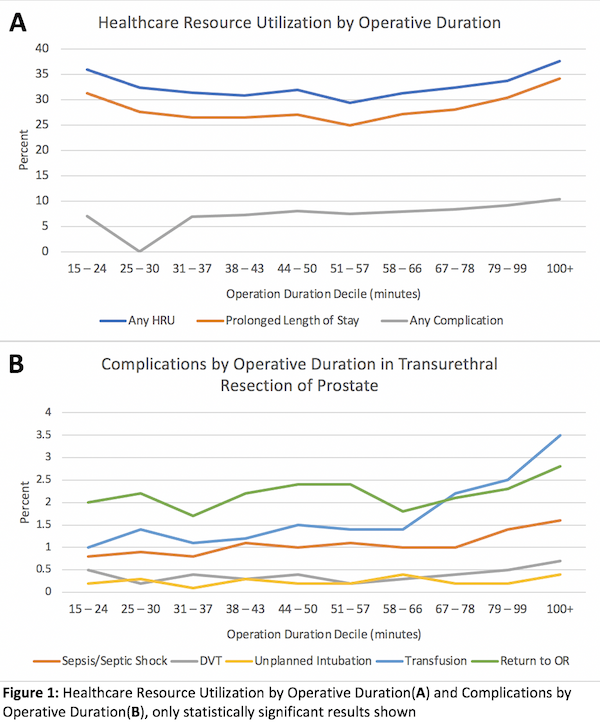Back
Poster, Podium & Video Sessions
Podium
PD39: Benign Prostatic Hyperplasia: Epidemiology, Evaluation & Medical Non-surgical Therapy
PD39-11: Evaluating Factors That Influence Healthcare Resource Utilization in Transurethral Resection of Prostate
Sunday, May 15, 2022
8:40 AM – 8:50 AM
Location: Room 243
Rebecca Edwins*, Amber Bettis, Andrew Harris, MD, Lexington, KY
- RE
Podium Presenter(s)
Introduction: Transurethral resection of prostate (TURP) remains the gold standard for treatment of benign prostatic hyperplasia (BPH) but is associated with various complications. The association of healthcare resource utilization (HRU) and TURP has been poorly studied. We seek to evaluate HRU in patients undergoing TURP and identify factors contributing to patient outcomes.
Methods: The American College of Surgeons National Surgical Quality Improvement Program (ACS NSQIP) database was reviewed from 2012 to 2018 for TURP by CPT code. HRU score was defined as discharge to continued care, unplanned readmission within 30 days, or prolonged length of stay (>75th percentile). We included multiple preoperative variables, including age, BMI, diabetes, and ASA class. OD was broken into deciles, approximately 3800 patients in each, by minutes, 15-24, 25-30, 31-37, 38-43, 44-50, 51-57, 58-66, 67-78, 79-99,>100. Preoperative characteristics and postoperative outcomes were compared against OD. Predictors of HRU were found using a stepwise multivariate logistic regression.
Results: There were a total of 38,749 patients. Variables significantly associated with OD (values stated are 3 shortest and 3 longest deciles, respectively): any HRU (35.9%, 32.4%, 31.4% and 32.4%, 33.7%, 37.6%), and prolonged length of stay (31.3%, 27.6%, 26.5% and 28.0%, 30.4%, 34.1%). Findings in the first decile seemed to be an outlier when compared with other shorter deciles, as can been seen in Figure 1a. Complications significantly associated with OD are shown in Figure 1b. On multivariable analysis, patients with OD > 58 minutes were significantly more likely to have increased HRU, odds ratio of 1.22, 1.33, 1.54, 1.78 for deciles 58-66, 67-78, 78-99 and >100, respectively, p<0.005. Preoperative variables found to be significantly associated with HRU on multivariable analysis include age 71-80 and >80, COPD, dyspnea, hypertension, diabetes, not functionally independent, ASA class III and IV-V, and dirty/infected wound class, p < 0.005.
Conclusions: Even when adjusting for patient specific preoperative factors, OD is an independent predictor of HRU in patients undergoing TURP. Patients in the longest decile were significantly more likely to have complications and increased HRU. Further study is needed to evaluate causation.
Source of Funding: N/A

Methods: The American College of Surgeons National Surgical Quality Improvement Program (ACS NSQIP) database was reviewed from 2012 to 2018 for TURP by CPT code. HRU score was defined as discharge to continued care, unplanned readmission within 30 days, or prolonged length of stay (>75th percentile). We included multiple preoperative variables, including age, BMI, diabetes, and ASA class. OD was broken into deciles, approximately 3800 patients in each, by minutes, 15-24, 25-30, 31-37, 38-43, 44-50, 51-57, 58-66, 67-78, 79-99,>100. Preoperative characteristics and postoperative outcomes were compared against OD. Predictors of HRU were found using a stepwise multivariate logistic regression.
Results: There were a total of 38,749 patients. Variables significantly associated with OD (values stated are 3 shortest and 3 longest deciles, respectively): any HRU (35.9%, 32.4%, 31.4% and 32.4%, 33.7%, 37.6%), and prolonged length of stay (31.3%, 27.6%, 26.5% and 28.0%, 30.4%, 34.1%). Findings in the first decile seemed to be an outlier when compared with other shorter deciles, as can been seen in Figure 1a. Complications significantly associated with OD are shown in Figure 1b. On multivariable analysis, patients with OD > 58 minutes were significantly more likely to have increased HRU, odds ratio of 1.22, 1.33, 1.54, 1.78 for deciles 58-66, 67-78, 78-99 and >100, respectively, p<0.005. Preoperative variables found to be significantly associated with HRU on multivariable analysis include age 71-80 and >80, COPD, dyspnea, hypertension, diabetes, not functionally independent, ASA class III and IV-V, and dirty/infected wound class, p < 0.005.
Conclusions: Even when adjusting for patient specific preoperative factors, OD is an independent predictor of HRU in patients undergoing TURP. Patients in the longest decile were significantly more likely to have complications and increased HRU. Further study is needed to evaluate causation.
Source of Funding: N/A


.jpg)
.jpg)